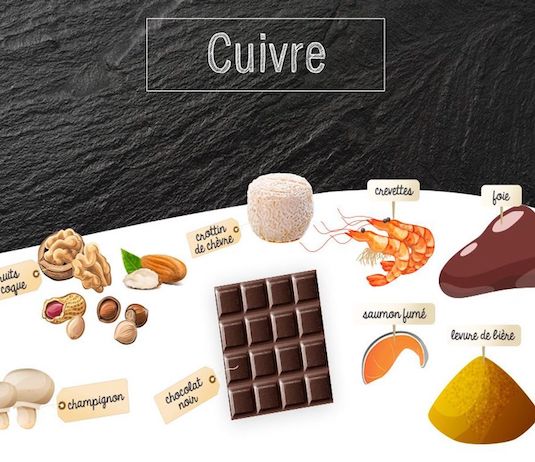CHARACTERISTICS :
Even more pro-oxidant and pro-inflammatory than iron.
 Paradox: we used the trace element Cu as an anti-inflammatory because everything that is pro-oxidant has an indirect anti-inflammatory effect, if we inject the oxidant, it stimulates the defenses (superoxide dismutase, catalases, glutathione peroxidase ) to defend oneself => but poor benefit / risk ratio
Paradox: we used the trace element Cu as an anti-inflammatory because everything that is pro-oxidant has an indirect anti-inflammatory effect, if we inject the oxidant, it stimulates the defenses (superoxide dismutase, catalases, glutathione peroxidase ) to defend oneself => but poor benefit / risk ratio
Copper increased if:
- Transport protein, ceruleoplasmin rises in the event of inflammation, it is an inflammatory protein. It is an inflammatory marker and an agent of oxidative damage.
- In case of infection, inflammation, cancer, the blood Cu rises. On the other hand, Iron and Zinc decrease because they are mobilized in the liver.
- The pill raises copper levels
- Estrogens cause an increase in copper (pregnancy) => hyperpigmention, rate multiplied by 5 and this creates oxidative stress for pregnant women.
- The carcinogenic nature of estrogen can be partially attributed to this rise in copper, which has a poor prognosis in the development of the cancers studied.
- Cu destroys antioxidants: vitamin C, Vitamin E, Beta-carotene, thiol groups.
To reduce Copper:
- Polyphenols can neutralize copper without becoming pro-oxidant, unlike conventional antioxidants
- Alpha lipoic acid
- Zinc and copper antagonize each other, when we give zinc, we induce the synthesis of a complex protein (metallothionine, a thiol group with affinity for zinc) which can block Cu, heavy metals).
But do not give too much zinc because it induces the synthesis of metallothionine in the digestive tract and its absorption is reduced.
RDA: 0.9 to 1.2 mg / d (experts believe it is overestimated)
ROLES:
1- The most pro-oxidant of all micronutrients:
- Makes antioxidants pro-oxidants (vitamin E)
- Make Radical Hydroxyl (OH °) with H202 (hydrogen peroxide)
- – Copper participates as a cofactor in a number of reactions, one of which contributes to the fight against free radicals. Indeed, copper is the essential coenzyme of cytosolic superoxide dismutase (SOD Cu-Zn), which converts the superoxide anion into hydrogen peroxide (H202). This hydrogen peroxide must itself be neutralized, either by selenium glutathioneperoxidase (GPX Se), or by If the hydrogen peroxide is not neutralized, it can react with iron or copper and produce the hyperaggressive radical hydroxyl (OH °)
- If too much estrogen, increase in circulating Cu and ceruleoplasmin and decrease in antioxidants (vit E, carotenoids, etc.) therefore it promotes oxidative modification of LDL, promotes platelet activation, promotes inflammation.
- Copper is a catalyst for the oxidation of LDL cholesterol. People with advanced atheroma eventually develop copper-modified LDL-specific autoantibodies
- On the other hand, at physiological doses, participate as a coenzyme in the neutralization of the superoxide anion by SOD Cu-Zinc (hence great confusion which leads to see copper in antioxidant supplements! For example against AMD)
- Studies on the pro-oxidant effects of Copper:
- – Quintuple the thickness of the arterial wall
- – No more damage to DNA, white blood cells
- Copper citrate is a factor in multiple DNA damage at the level of the small curvatures of the double helix, less protected by histones
2- Pro-inflammatory:
- Anti-viral effect but it only has an effect inside the white blood cells, elsewhere than in the white blood cell it does a lot of damage because it is pro-inflammatory on the digestive tract, on the vessels, on the circulating lipids
3- Powerful promoter of angiogenesis
4- Neurotoxic
5- Transforms tyrosine into melanin (skin pigment)
6- Excess copper (like heavy metals) displaces zinc from P53 (zinc protein) and makes it ineffective, this is another mechanism (besides DNA damage and the promotion of angiogenesis ) by which it is carcinogenic
SOURCES:
Lack of copper is rare. It could affect around 10% of elderly patients As copper cannot be given as a supplement, nor even as trace elements (0.25 mg, but “naked” it is even more aggressive than iron), we cannot can recommend it only in food form. The richest products are liver (but organic) and seafood. It is also found in chocolate and legumes.
COMPLEMENTS:
Never give copper , even in the form of trace elements (even less with gold and silver, toxic substances)
=> its presence in supplements is associated with a significant increase in mortality! (Alzheimer’s, diabetes, cardiovascular, overweight, obesity, mortality).
=> more copper in tap water or supplements increases cognitive losses, the risk of Alzheimer’s and markedly mortality (for supplements).
Laboratories are developing anti-copper molecules not just against Wilson disease, but against
- inflammation
- fibrosis
- cardiovascular risks
- retinopathies
- neuropathies
- rheumatoid arthritis
- cancers (copper is a powerful stimulator of angiogenesis)
- AMD (where angiogenesis therefore plays an important role in the wet form, which causes the most blindness).
This list is not exhaustive. We should start by not giving any!
Author Jean-Paul Curtay

Leave a Reply